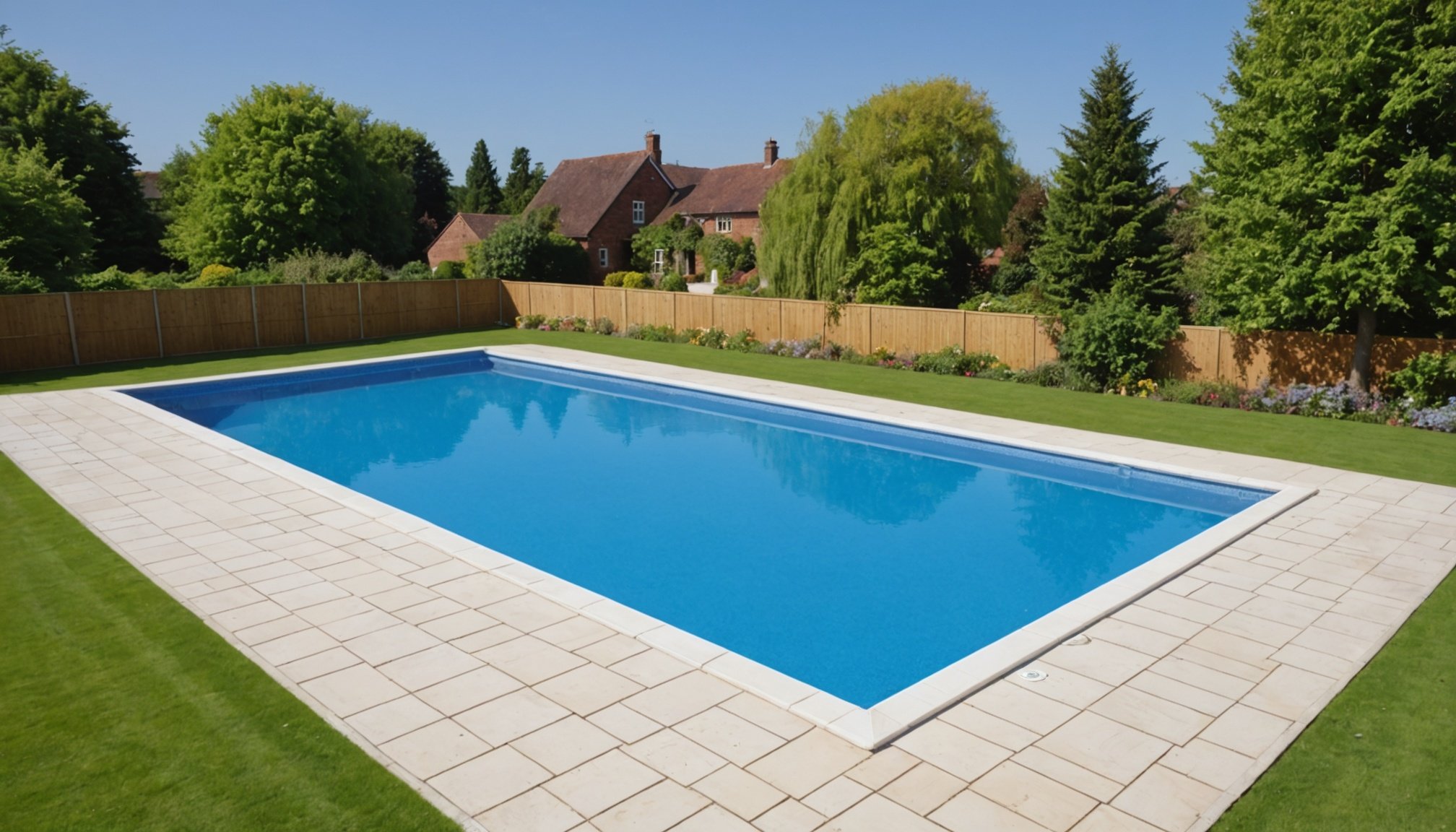Understanding the UK Climate and Its Impact on Pool Covers
The UK climate is known for its unpredictable weather patterns, which can significantly affect the choice of a pool cover. The region experiences moderate maritime weather with frequent shifts, particularly between seasons.
During the winter months, temperatures can drop, leading to potential freezing conditions. These conditions demand a durable pool cover that protects the water from contamination and debris, thus reducing the need for extensive cleanup when temperatures rise. Spring brings milder temperatures but also increased rainfall. A pool cover must effectively guard against these elements to maintain the pool’s cleanliness and stability.
A lire également : Essential Considerations for Choosing the Perfect Pool Slide for Your UK Home
Summers in the UK are relatively cool, often requiring pool covers that not only conserve warmth but also minimize evaporation. Autumn sees leaves and debris falling, necessitating a cover that can handle heavy debris without tearing or collapsing. Therefore, selecting a cover that is suitable for the UK climate is paramount for consistent maintenance.
When considering weather, the resilience of the pool cover, in response to varying conditions, ensures efficient pool management and longevity. By understanding these nuances, pool enthusiasts can make informed decisions, choosing a cover that matches their specific environmental and maintenance needs.
A découvrir également : Essential Tips for Safely Storing Pool Chemicals in the UK: A Comprehensive Guide
Types of Pool Covers for UK Residents
When selecting a pool cover, understanding its primary function and benefits is critical. Let’s explore the distinct types available.
Safety Covers
Safety covers are essential for protecting children and pets from accidental falls into the pool. They are crafted from strong, durable materials such as vinyl or mesh, ensuring they withstand pressure and environmental wear. It’s pivotal that these covers meet regulatory standards for installation and use, providing peace of mind to pool owners. Installation involves securely anchoring the cover to the pool deck, a process that should be precise to guarantee effectiveness.
Thermal Covers
Designed for heat retention, thermal covers significantly cut down on energy expenses. Available in types like bubble, solid, and insulated, each variety has unique purposes. Bubble covers are lightweight and perfect for warmer temperatures, while insulated options are more suited to cooler climates. Over time, thermal covers prove cost-effective by reducing the need to run pool heaters or filter systems constantly.
Winter and Summer Covers
Winter covers are heavier and designed to withstand severe weather, while summer covers are lighter for ease of use. The key is understanding seasonal usage: storing covers correctly during off-seasons prevents damage and extends their lifespan. Both influence water quality by preventing debris accumulation, necessitating less frequent chemical adjustments.
Benefits of Using a Pool Cover
Using a pool cover offers several remarkable benefits that maximize energy efficiency and contribute to cost savings. One of the primary advantages is the reduction in heating costs. By minimizing water evaporation, pool covers retain heat, allowing you to maintain a comfortable water temperature with less energy consumption.
Moreover, a pool cover significantly lowers chemical usage. The reduced evaporation means fewer water additives are needed, keeping the water quality pristine. This not only saves on chemical expenses but also promotes a healthier swimming environment.
In addition, pool covers provide notable time-saving features. They limit the amount of debris that accumulates in the pool, thereby reducing the need for frequent cleaning. This aspect directly cuts down the time and effort required to maintain your pool.
Furthermore, investing in a pool cover eventually leads to substantial cost savings. By decreasing energy and chemical expenses and shortening cleaning time, the overall operational costs of your pool can be significantly reduced over time. These benefits make pool covers an essential aspect of efficient and economical pool management.
Installation Tips for Pool Covers
When it comes to pool cover installation, whether you’re a DIY enthusiast or considering professional services, having a clear guide can be invaluable. Let’s explore some helpful tips and considerations.
Step-by-Step Installation Guide
For those keen on a DIY approach, the following guide will get you started:
- Measure your pool dimensions accurately to ensure the cover fits perfectly.
- Lay the cover flat over the pool, ensuring there are no wrinkles.
- Secure the edges using clips or anchors as specified in the instructions.
- Regularly check the cover for slack and adjust as necessary.
By following these steps, you’ll ensure a smooth installation process with minimal hassle.
Common Pitfalls
Several common mistakes can occur during pool cover installation. A frequent issue is failing to measure properly, which can lead to an ill-fitting cover. Additionally, ignoring potential wind exposure might result in damage or displacement.
Professional Services
If DIY becomes overwhelming or if your pool has specific challenges, consider hiring professional services. Professionals bring expertise and tools that can ensure a secure and efficient installation. They can address complex installations like irregularly shaped pools or those requiring custom covers.
Maintenance and Care for Pool Covers
Ensuring the longevity of your pool cover requires consistent attention and upkeep. Regular maintenance tasks are crucial to extending its lifespan. Begin by inspecting the cover for any visible damage, such as tears or punctures, which should be repaired immediately to prevent further deterioration. Dust and debris can accumulate quickly, so cleaning the surface regularly is recommended.
When planning your cleaning routine, consider using a soft-bristle brush and non-abrasive cleaner to avoid damage. Hosing down the cover with water can remove loose dirt. For seasonal care tips, ensure your pool cover is dry before storage to prevent mould and mildew.
Properly maintain the tension and alignment of the cover to avoid sagging. This may require tightening any supporting equipment, like anchors or straps.
In colder climates, clearing snow accumulation promptly can prevent undue stress on the fabric. During warmer months, protect the cover from prolonged UV exposure by using protectant sprays specifically made for pool materials. Additionally, examine the cover’s mechanical parts, like reels or rolls, as they can wear out with constant use.
By following these care tips, you ensure continued optimal performance, saving on replacement costs and enhancing the lifespan of your pool cover.
Product Recommendations and Reviews
Understanding the best pool cover options can be daunting with myriad choices available. Let’s dive into the details on how to make an informed purchase decision.
Top Recommended Brands
When searching for the best pool cover, it’s crucial to look at reputable brands renowned for durability and innovation. The market leaders consistently praised in pool cover reviews include names like Intex, Blue Wave, and In The Swim. These brands are known for offering unique features such as UV protection and fast drainage. Generally, Intex covers are appreciated for their affordability, Blue Wave for their extensive warranty options, and In The Swim for their superior fit. Consumer feedback frequently highlights the robust construction and ease of use of these products.
Where to Buy Pool Covers
While purchasing a pool cover, consider whether you’ll buy from online retailers or local stores. Online platforms often offer a broader selection and competitive pricing but might lack the personalised advice available at local stores. It’s essential to examine return policies and warranties. Aim for providers with flexible returns, ensuring you can exchange a cover that doesn’t fit your pool dimensions properly.











